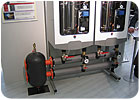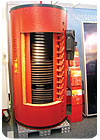
The International Heating and Sanitation (ISH) show presented by Messe Frankfurt is a biennial venue for checking out the latest plumbing and heating hardware from around the world. Last March was the latest offering of this “greatest show on earth” for plumbing and heating aficionados.
I was fortunate enough to roam the halls of ISH for three days in search of the latest hydronic heating products and system design concepts. I saw hardware ranging from a matchbook-sized circulator to residential fuel cells that provide both heat and electricity.
While kicking the tires it became apparent that differences in heating hardware are in large part due to differences in culture. The hydronic hardware and system concepts used in Europe facilitate the needs, desires and attitudes of European consumers regarding comfort heating and energy use in general. It doesn’t take long to realize these are distinctly different from those of a typical American consumer.
Sure, both Americans and Europeans want comfort. Sure, we both think energy efficiency is a good idea. But daily life forces Europeans to stay focused on energy conservation and environmental sustainability. They simply don’t have the luxury of cheap and abundant energy (think $6.30 per gallon for gasoline).
It’s also evident that while price is a part of buying decisions, it doesn’t automatically trump quality, long-term reliability or efficiency, nor does it displace the need to do the installation properly.
No-Shows
I’m sure you’ll read reports on wonderful products other Americans saw at ISH. Rather than just give you more of the same, I’d rather tell you what I didn’t see there. As you read through the list, ask yourself why Europeans and those from other countries don’t subscribe to some of the installation practices that North Americans often accept as normal and sufficient.
Nowhere did I see anything resembling the plateless underfloor staple-up systems currently being tacked into some American homes. In Europe, everywhere that radiant panel tubing goes, so does a capable means of heat dispersal, such as form-fitting aluminum plates or poured thermal mass.
Maybe they haven’t figured out that the plates can be eliminated? Perhaps they feel compelled to invest more in the system than necessary. Or could it be that the many fiercely competitive companies serving the largest panel heating market in the world all understand it takes more than a staple gun and a roll of PEX to install an efficient and comfortable radiant panel system? My bet is on the latter.
What I didn’t see was fin-tube baseboard. Even with entry-level systems, Europeans grasp the difference between radiant and convective heat delivery and its impact on comfort. They pay the price necessary to achieve the right balance. At the “designer” level, they’ll build just about anything you can dream up and make it function as a radiator.
Don’t get me wrong. I’m not suggesting that primary/secondary doesn’t work. Instead, I’m pointing out that hydraulic separation of circuits, the underlying reason to consider p/s piping, can be accomplished without a primary loop and its associated circulator. One less pump translates into significant savings over the life of the system, especially when you live in Europe where electricity costs $0.25 or more per kwhr.
You see this in the “industrial design” of their products. In some cases, the outward appearance of a product reveals little about its function. A peek under the hood is needed to see if the typically clean-lined cabinet contains a compressor (it’s probably a heat pump), a combustion system (it’s probably a boiler), or perhaps even an engine (it’s a cogen system).
Almost every one of these devices also contains a microprocessor to precisely manage whatever it’s supposed to do.
You also see attention to detail in their installations. For example, rather than joining three or four fittings together to mount a component to a piping system, they create a specialty fitting or add a tapping to another component. The systems they build look good. They’re also easy to service with plenty of isolation and draining capability where needed.
Modular design is also common. Think of a low loss header system as the “backbone” of a typical system with mixing modules or pumping blocks added as the “ribs” necessary to achieve the desired functionality.
From the standpoint of initial cost, it’s less expensive to install a smaller heat exchanger and force the necessary rate of heat transfer through it using higher boiler temperature. From the standpoint of efficiency, it’s better to increase the surface area of the coil and reduce the water temperature supplied by the boiler.
So which approach do you think the Europeans opt for? That’s right: increased coil surface area. There were dozens of cut-away tanks on display at ISH with generously sized internal heat exchangers. Many companies offered tanks with two, three and even four independently piped internal coils to accommodate heat input from solar or wood-fired subsystems, and to let the tank act as a buffering thermal mass in the system (see Figure 2).
These tanks provided properly placed sensor wells, thick insulation (3+ inches of urethane foam), and internal baffling to promote stratification. What a concept, and what an opportunity for some visionary manufacturer to bring to the North American market.

After all this, you may think of me as Eurocentric, or perhaps just in a mood to dump on the North American hydronics industry. Let me assure you this is not the case.
There’s no question in my mind that North America has technology that equals or exceeds that available in Europe. The “wow” products shown at ISH weren’t designed by rocket scientists from a superior race. They were built using the same metals, polymers, electronics and manufacturing methods available in North America. Everything I saw over there could be built over here. We just need a bit more “cultural incentive” to make it happen.
There are valuable lessons in seeing how others harness the same physics that govern all hydronic systems regardless of continent or culture. It’s only human to desire the highest performance for the lowest possible price. It’s also inevitable that North Americans and Europeans will continually pursue increasing the ratio of performance to price.
But let’s face it, they’ve been at this longer than we have, and it’s wise to respect experience that knows where to draw the line in these pursuits.


